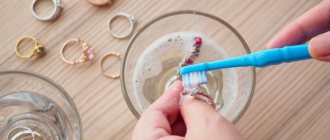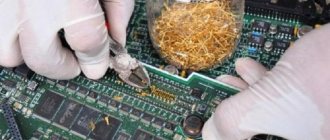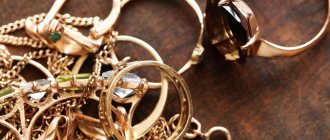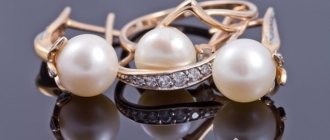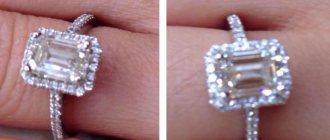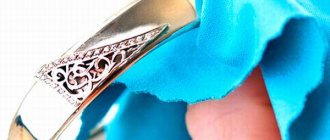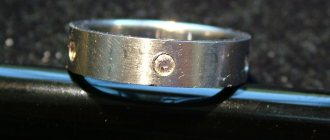Gold is one of the most popular metals. It has always been in fashion; gold jewelry is still purchased by many people to this day.
Also, gold has always been a profitable solution for deposits and storing money, especially during periods of crises and economic instability. But because of this popularity, scammers have long appeared who counterfeit gold jewelry. No one likes to be deceived when buying expensive products. And therefore you need to understand and know how the gold standard is determined at home.
What is a gold sample and how to check it? Many people know that among gold products there are practically no items consisting entirely of this metal. And in most cases, they additionally contain other elements, such as silver, copper or nickel. They are added to increase the strength of the alloy, because gold is a very soft metal. Sometimes this is done simply to diversify the color component - as a result, jewelry can become pink, reddish or even greenish.
A three-digit number is stamped on the gold—the hallmark itself. It indicates the ratio of the amount of precious metal in the jewelry. The hallmarks are different, for Russia, for example, the following are established: 375, 500, 585, 750, 950, 999. And these numbers mean how many parts of the metal in the jewelry out of a thousand are gold. For example, 750 standard - per thousand pieces of jewelry 750 is made of precious metal, that is, 75% of the jewelry is gold.
Unlike Russia and the CIS countries, in the rest of the world the quality of gold products is determined using karats. The maximum number of carats for the alloy is 24, which means that the jewelry is entirely gold. To convert foreign carats into the standard we are used to (for example, when buying jewelry abroad), you need to do the following: divide the number of carats by 24, and multiply the result by a thousand. For example: 18-karat gold: 18÷24*100 = 750. Result: 18-karat is equal to the 750th standard. By calculations you can get the following comparison table:
| Carats | Try | Gold percentage |
| 24 | 999 | 100% |
| 18 | 750 | 75% |
| 14 | 585 | 58,5% |
| 12 | 500 | 50% |
| 9 | 375 | 37,5% |
| 8 | 333 | 33,3% |
It is possible that the sample is missing. It may be missing if the product has been altered or restored.
Visual inspection
It is difficult for a non-specialist to determine what metal the jewelry is made of. Therefore, it is important to understand what kind of product it is. Even a visual inspection will reveal a fake. Inspect the decoration carefully.
- Joints and soldered elements are hidden. Use a magnifying glass or smartphone. Take a photo, enlarge the photo.
- Pay attention to the mark. Its edges are smooth. A homemade stamp will be crooked, and individual elements will be unevenly located.
- Look closely to see if the color is uniform. The fake one has uneven color. Scuffs mean spraying was used. Look at the solder lines where the two parts join.
- Rate the aroma. The 585 grade product has no odor. Warm the decoration and then smell it. The fake will have a strong metallic aroma.
- Look at the joints: light-colored metal is used for solder. There are no green or yellow lines on the solder that appear when the weighting material is soldered.
- Shine in the sun. 585 gold shines even in low light, other metals fade. The intensity of the shine is not retained by a fake with gilding.
Sample determination using improvised methods
Different alloys have different densities, which also applies to gold samples. If you have accurate scales at home, you can determine the density of gold using them. For this:
- We weigh the product on precise scales, but it should not have stones or voids to which water will not have access. We remember the value of its mass.
- Place a glass of water on the scale. We lower the decoration into the water on a string so that it does not touch the walls of the glass, and weigh it again.
- Divide the first value by the second - this will be the density.
If the product has a density of 11.5 g/cm3, then it is 373 gold; a product made of 575 gold should have a density of about 13-13.5 g/cm3. If it is white gold, then with the same standard it can have a higher density of almost 15 g/cm3 - this indicates that it contains palladium. 750 gold has a density of 15.5 g/cm3, with the exception of white gold containing palladium, where the density is 16.5 g/cm3.
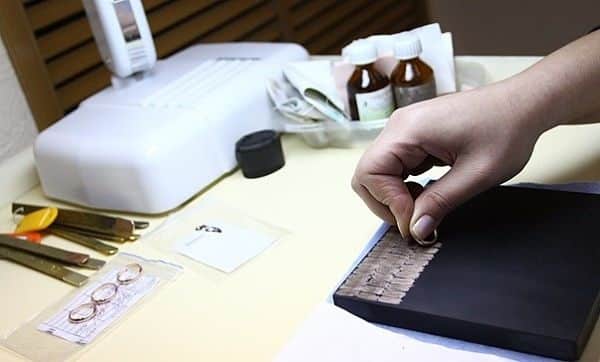
Determining the purity of gold by contact with another gold item
There are also some differences in the color and characteristics of the metal. Higher grades have higher color saturation. But this method makes sense only when the alloys are made in accordance with state standards.
The brightest and most saturated color of jewelry is 750. It is almost impossible to confuse these products with lower quality ones. In addition, this gold will be much softer than its analogues. If the product has a small volume, then it must be handled very carefully, as it is subject to deformation. Therefore, products made from this sample are most often massive. It is the most popular sample in the West.
585 jewelry has a more neutral color - it is not bright, but not dull either. In terms of price-quality characteristics, such an alloy is considered optimal. It is great for products with stones.
375 gold has a grayish tint; its color is less saturated and duller. But such jewelry is the most durable and wear-resistant due to the fact that the alloy is the hardest. The color of products of even lower and very rare 333 standard will also be dull.
Checking with an electronic detector
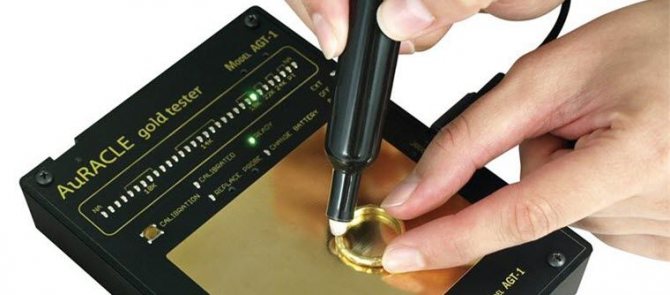
It is not profitable to buy such a device for a single use; ask if your friends have such a tool. An electronic detector determines the quality of the alloy using a special reagent, as well as: sample, composition, proportion of alloy, type of metal. The appearance of the decoration is preserved, since no cuts are made.
Determining the fineness of a gold product
Once it has been determined that the product is genuine, you can begin to determine its sample. You can find out using the following methods:
- chemical reagent - drop method;
- using an electronic detector;
- assay needle and touchstone.
Drip method
To determine the gold sample, you will need one of the chemical reagents. The method is quite complicated to carry out at home due to the possible lack of necessary substances or experience in performing the process. But it is carried out simply and quickly, and is quite reliable.
First, you will have to clean part of the surface of the product with a file. After this, apply a drop of the reagent to the cleaned area. After 10-20 seconds, the reagent must be removed from the surface and the changed color of gold must be assessed.
For gold less than 600 purity, gold chloride is used. For other cases, other acid reagents are suitable. The color of the stain that appears on the metal depends on the sample (for example, at 585 it is light brown, and at 375 it is green). We also pay attention to the brightness of the color: darker color means less sample. To accurately determine the shade and, accordingly, the sample, experience is needed, so this method is used mainly only by specialists.
Determination using an electronic detector
You can also determine the gold sample at home using an electronic detector. The principle of its operation is based on the electrical and chemical reactions of metals. You can find out the sample of gold very accurately, and it does it incredibly quickly - within five seconds.
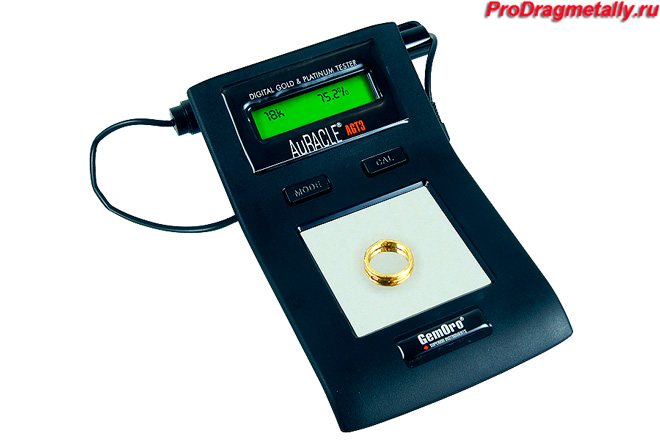
Using the device, you can easily distinguish a gold-plated fake from a genuine product and even calculate the exact amount of gold in it!
The range for the detector is six to eighteen carats - range 333-750 for samples. The results obtained are shown in carats.
Despite all its capabilities, the price of such a device is not prohibitively high. Electronic detectors are available in any jewelry workshops, shops and pawn shops. But most people still believe that such a device is not suitable for home use, and purchasing it is not a cost-effective solution.
How to distinguish gold from gilding
You should study the decoration in detail. There should be no scratches on it, much less abrasions. Perfectly smooth surface. Try scraping the product a little in an invisible area. The spray will come off slightly.
At home, you can use a lapis pencil. You can easily buy it at a pharmacy. A small cut is made on the sample being tested in an inconspicuous place and washed with water. Next, draw with a lapis pencil and observe. If the area has not darkened, then the product is made of real gold. Other metals immediately give a dark color.
Some unscrupulous sellers pass off brass items as gold . Their color is very similar. How to distinguish a fake?
- if the color of the product is slightly different from the usual gold color, then it is better to refrain from purchasing;
- too attractive low prices for jewelry also cast doubt on their quality;
- Brass, although similar in color to gold, is much lighter in weight than this noble metal. The weight of the product being too light should alert you.
Current gold standard standards in Russia
A sampling system was introduced to determine the quantitative content of precious metal in the alloy. Such additives are called ligatures.
Gold purified from impurities has a purity of 999.9. Metal of such purity can only be found in bank bullion. Jewelers can make an alloy with any proportion of precious metal.
Absolutely all products made of precious metals that are sold through retail chains or imported are subject to testing. This process is under state control. The Assay Office authorities apply a special stamp on each product, confirming the sample of the alloy.
To systematize branding, state sample systems have been adopted. The most common ones are currently metric and carat.
Metric
It was introduced into the USSR in 1927 instead of the spool valve. Determines the number of units of gold in 1000 units of jewelry alloy. Modern gold jewelry is hallmarked with 375, 500, 585, 750, 900, 958, and 999 hallmarks. Used 583 until 1999. Changed to 585 to match Western 14K value.
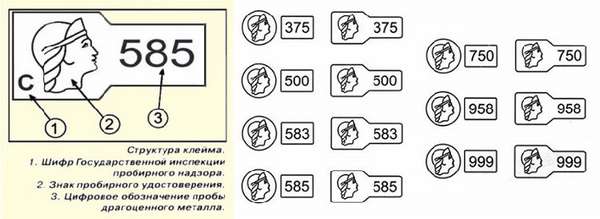
Zolotnikovaya
Operated in Tsarist Russia, then in the Soviet Union until 1927. Measurements were based on a weight measure of one pound. The spool is 1/96th part. The most used spool samples are 56, 72, 92. Such markings can still be found on antique products.
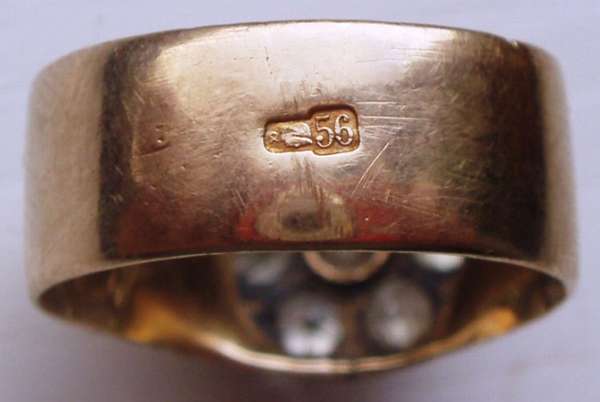
Carat
This is the British marking system, common in Western Europe and the USA. A carat is a measure of weight equal to 0.2 g. One thousand units of the metric system corresponds to 24 carats.
24K pure gold, without added ligature. In jewelry production, 9, 10, 14, 18 carat samples are used. To convert the value into the usual metric ones, you need to divide the value in K by 24 and multiply by 1000.
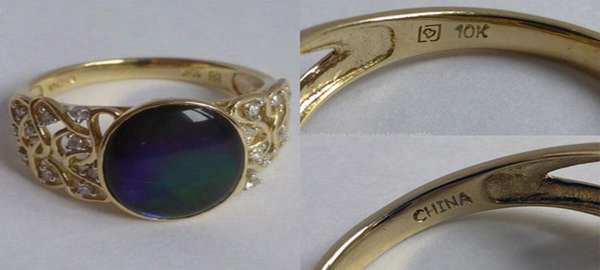
Chemical methods
Gold is an inert metal. It does not react with many chemicals. The ligature reacts mainly. Experts use acid reagents for various gold samples. In everyday life, you can use iodine, ammonia, vinegar, lapis pencil or even black bread.
Iodine and vinegar
Gold is the only metal that does not react with iodine. Before applying iodine, the surface of the product must be cleaned, for example, by rubbing it on a thick cloth. If the metal is not precious, the iodine will darken the area. High grade gold will not react. The degree of burn can be used to judge the alloy sample. The iodine trace is removed by wiping with ammonia or soaking in Coca-Cola.
Every home has a bottle of vinegar. It can also be used to check the authenticity of gold. The product must be immersed in a glass of vinegar for at least five minutes. If the fake gets dark. Real gold alloy vinegar is not afraid!
Black bread
Such a check will require time and black bread. The crumb is wetted in water. The resulting mass is tightly wrapped around the product. You can break the crumb after it has completely dried.
You should carefully inspect the inner surface of the bread mass. Green, dark spots indicate oxidative processes that are not typical for high-grade gold.
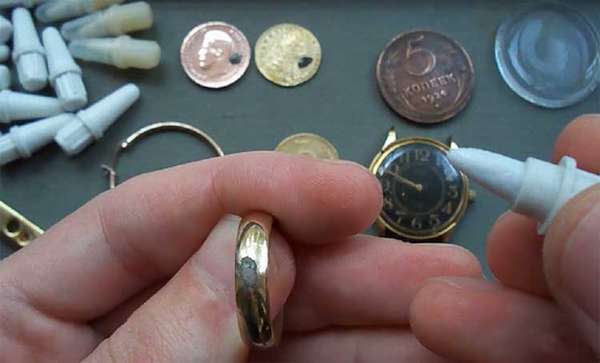
lapis pencil
Lapis is sold at the pharmacy. It is an antiseptic used to stop bleeding. You can check gold using it as follows:
- make a notch
- wet the pencil with water
- anoint the cut area,
- wait up to 5 minutes for a reaction.
Gold does not react to lapis. An oxidized mark will remain on a fake or low-grade gold alloy.
Ammonia
Ammonia (ammonia) does not leave any traces on the surface of gold. The substance is even used to clean jewelry. If cloudiness or a dark mark appears on the surface, it is not a precious metal or gold plated. It is impossible to accurately determine the sample using this method.
